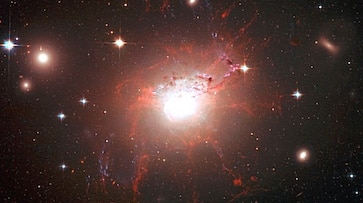The ultraviolet imaging telescope of the Astrosat, India's first dedicated multi-wavelength space satellite, has spotted rare hot ultraviolet-bright stars in the Milky Way galaxy
Bengaluru: The ultraviolet imaging telescope of the Astrosat, India's first dedicated multi-wavelength space satellite, has spotted rare hot ultraviolet-bright stars in the Milky Way galaxy, as per a ministry of science and technology statement.
These stars whose inner core is almost exposed, making them very hot, exist in the late stages of evolution of a Sun-like star. It is not clear how these stars end their lives as not many of them are detected in these fast-evolving phases, making their study crucial, the ministry said.
With spectacular ultraviolet images of the cluster from Ultraviolet Imaging Telescope (UVIT) onboard India’s first multi-wavelength space satellite, AstroSat, the scientists at the Indian Institute of Astrophysics (IIA) distinguished the hot UV-bright stars from the relatively cooler red giant and main-sequence stars which appear dim in these images.
The findings of this study have been accepted for publication in the journal ‘The Astrophysical Journal’.
Motivated by the fact that old globular clusters referred to as dinosaurs of the universe present excellent laboratories where astronomers can understand how stars evolve through various phases between their birth and death, the scientists at IIA looked out for NGC 2808, a massive globular cluster in the Milky Way galaxy.
The team of scientists comprising Deepthi S Prabhu, Annapurni Subramaniam and Snehalata Sahu from IIA combined the UVIT data with observations made using other space missions such as the Hubble Space Telescope and the Gaia telescope along with ground-based optical observations.
Last Updated Jan 22, 2021, 1:11 PM IST









![Salman Khan sets stage on fire for Anant Ambani, Radhika Merchant pre-wedding festivities [WATCH] ATG](https://static-gi.asianetnews.com/images/01hr1hh8y86gvb4kbqgnyhc0w0/whatsapp-image-2024-03-03-at-12-24-37-pm_100x60xt.jpg)
![Pregnant Deepika Padukone dances with Ranveer Singh at Anant Ambani, Radhika Merchant pre-wedding bash [WATCH] ATG](https://static-gi.asianetnews.com/images/01hr1ffyd3nzqzgm6ba0k87vr8/whatsapp-image-2024-03-03-at-11-45-35-am_100x60xt.jpg)


